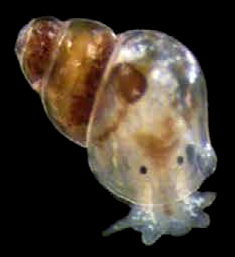
The blennioid family Chaenopsidae includes the pike-blennies, tube-blennies, and flagblennies, all percomorph marine fish in the order Blenniiformes. The family is strictly tropical, ranging from North to South America. Members are also present in waters off Japan, Taiwan and Korea. Fourteen genera and 90 species are represented, the largest being the sarcastic fringehead, Neoclinus blanchardi, at 30 cm (12 in) in length; most are much smaller, and the group includes perhaps the smallest of all vertebrates, Acanthemblemaria paula, measuring just 1.3 cm (0.51 in) long as an adult.
Diaphanidae is a taxonomic family of small sea snails, marine opisthobranch gastropod molluscs or micromollusks in the superfamily Diaphanoidea, the headshield slugs and bubble snails.

Giuseppe Antonio Risso, called Antoine Risso, was a Niçard and naturalist.

Eucobresia diaphana is a species of small air-breathing land snail or semi-slug in the terrestrial pulmonate gastropod mollusk family Vitrinidae.

Samoana diaphana, one of several species also known as the Moorean viviparous tree snail or the Polynesian tree snail, is a species of tropical, air-breathing land snail, a terrestrial, pulmonate, gastropod mollusk in the family Partulidae. This species is endemic to French Polynesia.
Notosetia is a genus of minute sea snails or micromolluscs, marine gastropod molluscs in the family Turbinidae.
Laevilitorina is a genus of small sea snails, marine gastropod molluscs in the family Littorinidae, the winkles or periwinkles.

Rissoa is a genus of minute sea snails, marine gastropod mollusks or micromollusks in the family Rissoidae.

Setia is a genus of minute sea snails, marine gastropod mollusks or micromollusks in the family Rissoidae.

Emblemariopsis diaphana, the glass blenny, is a species of chaenopsid blenny found in coral reefs in the Florida Keys, USA, in the western central Atlantic ocean. It can reach a maximum length of 4 centimetres (1.6 in) TL. The specific name refers to this species being "largely translucent" in life, although this is lost in preserved specimens. E. diaphana is the type species of the genus Emblemariopsis.

Ondina diaphana is a species of sea snail, a marine gastropod mollusk in the family Pyramidellidae, the pyrams and their allies.

Retusa is a genus of very small head-shield sea snails or barrel-bubble snails, marine gastropod mollusks in the family Retusidae.
Aiptasia diaphana, commonly known as the yellow aiptasia or glasrose, is a species of sea anemone native to shallow waters in the temperate eastern Atlantic Ocean and the Mediterranean Sea. It has been introduced into the Red Sea.

Delias diaphana is a species of pierine butterfly endemic to the Philippines, where it is found only on Mindanao.

Sternoptyx diaphana, the diaphanous hatchetfish, is a species of deep sea ray-finned fish in the family Sternoptychidae. It is the type species of the genus Sternoptyx, and was first described by the French naturalist Johann Hermann in Der Naturforscher 1781.

Exaiptasia is a genus of sea anemone in the family Aiptasiidae, native to shallow waters in the temperate western Atlantic Ocean, the Caribbean Sea and the Gulf of Mexico. It is monotypic with a single species, Exaiptasia diaphana, and commonly known as the brown anemone, glass anemone, pale anemone, or simply as Aiptasia.

Rissoella opalina is a species of sea snail, a marine gastropod mollusk in the family Rissoellidae.

Rissoella verruculosa is a species of red algae, the only accepted species in the genus Risoella and the family Rissoellaceae. This species is endemic to the Mediterranean Sea.
Diaphana is a genus of gastropods belonging to the family Diaphanidae.














